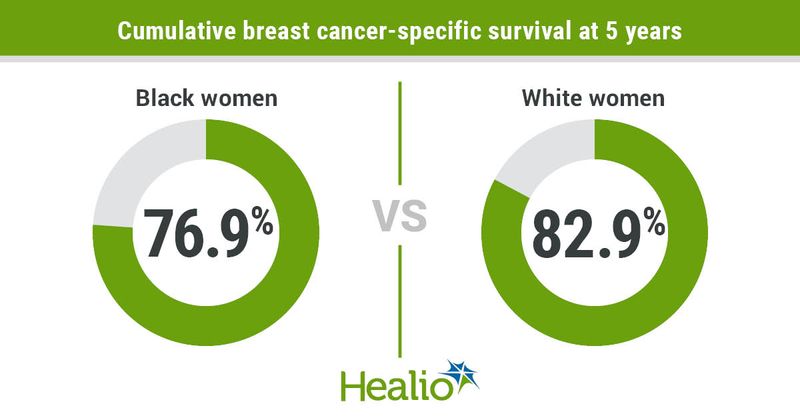Black women at higher risk for triple-negative breast cancer mortality
Black women had a significantly higher risk for death due to nonmetastatic triple-negative breast cancer than white women, according to study results published in JAMA Oncology.
The difference may be partially explained by disparities in receipt of surgery and chemotherapy, researchers noted.

“Black women experience a disproportional burden of poor breast cancer outcomes than white women, which is associated with a higher incidence of triple-negative breast cancer, more advanced stage at diagnosis and lower treatment adherence,” Ying Liu, MD, PhD, assistant professor in the department of surgery and division of public health sciences at Washington University School of Medicine in St. Louis, told Healio. “However, the differences in clinical treatment and outcomes between Black women with triple-negative breast cancer and their white counterparts have not been well-defined. Therefore, we comprehensively examined the differences in treatment and survival outcomes between these two racial and ethnic groups in a nationally representative cohort of [patients with triple-negative breast cancer].”

The population-based, retrospective cohort study included 23,123 women (74.7%, white; 25.3%, Black) identified in the SEER database who had been diagnosed with nonmetastatic triple-negative breast cancer between 2010 and 2015 and followed through 2016.
Black women tended to be younger at triple-negative breast cancer diagnosis (average age, 56.3 years vs. 59.7 years), and appeared more likely to be insured through Medicaid (20.6% vs. 8.8%) and reside in the most deprived counties (14.7% vs. 7.1%) and urban counties (92.1% vs. 86.2%).
In addition, a greater proportion of Black women had stage III tumors (20.3% vs. 15.2%), tumors exceeding 5 cm in size (14.3% vs. 9.6%), positive lymph nodes (39% vs. 31.6%) and poor differentiation or undifferentiation (81.5% vs. 76%).
Researchers used logistic regression analysis and competing risk regression analysis to estimate ORs of treatment receipt and HRs of breast cancer mortality among Black women compared with white women.
During median follow-up of 43 months (interquartile range, 22-59), results showed an overall mortality rate of 14.2%. Black women had a higher rate of breast cancer-specific mortality than white women (16.8% vs. 13.2%), but a slightly lower rate of death due to other causes (4.5% vs. 5%).
Cumulative breast cancer-specific survival appeared significantly lower (P < .001) among Black women, with a 5-year survival rate of 76.9% vs. 82.9% for white women.
Researchers reported an HR for breast cancer mortality of 1.28 (95% CI, 1.18-1.38) for Black women vs. white women after adjusting for sociodemographic and county-level factors, and an HR of 1.16 (95% CI, 1.06-1.25) after further adjustment for clinicopathologic and treatment factors.
Most women underwent surgical treatments (94.7%), chemotherapy (74.5%) and/or radiation therapy (51.9%). However, Black women had lower odds of receiving surgery (OR = 0.69; 95% CI, 0.6-0.79) and chemotherapy (OR = 0.89; 95% CI, 0.81-0.99) compared with white women after adjusting for sociodemographic, clinicopathologic and county-level factors.
Moreover, race-associated risk for triple-negative breast cancer mortality appeared highest among women residing in socioeconomically less deprived counties (HR = 1.26; 95% CI, 1.14-1.39), urban women (HR = 1.21; 95% CI, 1.11-1.32), women with stage II (HR = 1.19; 95% CI, 1.02-1.39) or stage III (HR = 1.15; 95% CI, 1.01-1.31) tumors that were treated with chemotherapy, and women aged younger than 65 years (HR = 1.24; 95% CI, 1.12-1.37).
“Improving treatment adherence and efficacy in Black women with triple-negative breast cancer is crucial in reducing triple-negative breast cancer outcome disparities,” Liu said. “I am currently working with biologists to identify the biological differences between triple-negative breast cancers of Blacks vs. whites. Future studies will also examine the roles of treatment details, lifestyles, comorbid health conditions and social factors in explaining the excess mortality risk among Black women.”
For more information:
Ying Liu, MD, PhD, can be reached at Washington University School of Medicine in St. Louis, 660 S. Euclid Ave., Campus Box 8100, St. Louis, MO 63110; email: yliu3@wustl.edu.


